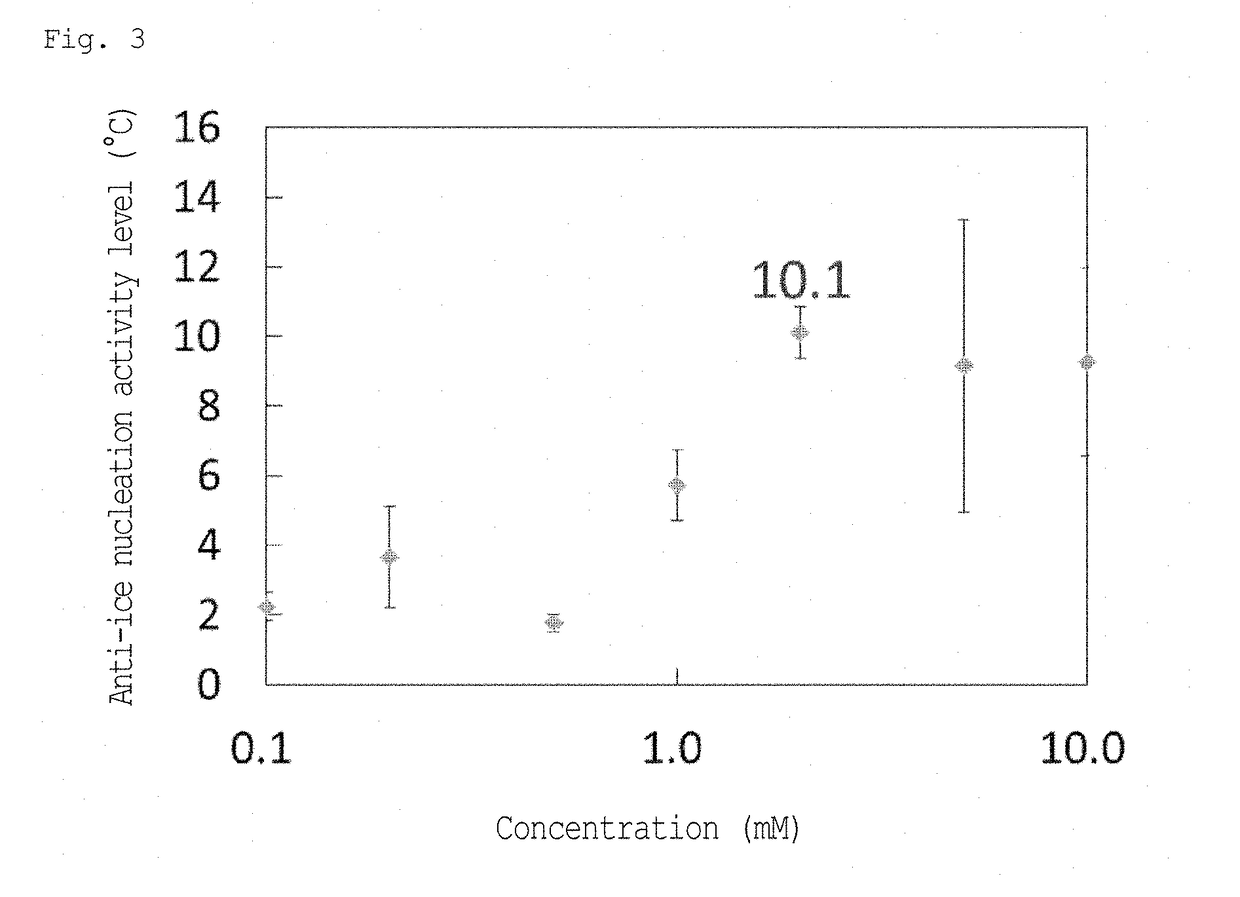Agent having Anti-ice nucleation activity
a technology of nucleation activity and activator, which is applied in the field anti-freeze liquid, and anti-freeze liquid, can solve the problems of low anti-ice nucleation activity towards silver iodide, and the use of anti-ice nucleation activator is difficult in the fields of food and biomaterials, so as to prevent frost damage and enable long-term, low-temperature preservation of food.
- Summary
- Abstract
- Description
- Claims
- Application Information
AI Technical Summary
Benefits of technology
Problems solved by technology
Method used
Image
Examples
production example 1
[0195]Fmoc-Tyr(tBu)-Alko-PEG Resin (0.917 g, 0.220 mmol) was swollen for 30 minutes with a 25% DMSO / DMF solution. Thereafter, a step of replacing the solvent in the resin with a large amount of DMF for 1 minute, and removing DMF (hereinafter referred to as “the replacing step”) was repeated three times, and subsequently the Fmoc group was removed from the Fmoc-Tyr(tBu)-Alko-PEG Resin using a 20% PPD / DMF solution. Using the obtained Tyr(tBu)-Alko-PEG Resin, the replacing step that uses DMF for 1 minute was performed 3 times, and sequentially the replacing step that uses methanol for 1 minute was performed 3 times.
[0196]Subsequently, the obtained Tyr(tBu)-Alko-PEG Resin was swollen for 30 minutes with a 25% DMSO / DMF solution. Thereafter, using the Tyr(tBu)-Alko-PEG Resin, the replacing step that uses DMF for 1 minute was performed 3 times, and Fmoc-Tyr(tBu)-OH (3.0 eq), NMM (3.0 eq), and DMT-MM (3.0 eq) were added to this resin to perform a condensation reaction for 120 ...
production example 2
[0200]The Fmoc-Tyr(tBu)-Tyr(tBu)-Alko-PEG Resin obtained in Production Example 1 was repeatedly subjected to the method described in Production Example 1, and Tyr(tBu)-Tyr(tBu)-Alko-PEG Resin and Fmoc-Tyr(tBu)-OH (3.0 eq) were subjected to a condensation reaction to obtain Fmoc-Tyr(tBu)-Tyr(tBu)-Tyr(tBu)-Alko-PEG Resin. Thereafter, a tyrosine trimer, i.e., the target product, was obtained in accordance with a purification method similar to that described in Production Example 1. The HPLC analysis confirmed that this compound exhibited a single peak.[0201]Tyrosine trimer:[0202]MALDI-TOF-MA: [M+H]+=508.267, [M+Na]+=530.306, [M+K]+=546.244
production example 3
Tyrosine Tetramer
[0203]The Fmoc-Tyr(tBu)-Tyr(tBu)-Tyr(tBu)-Alko-PEG Resin obtained in Production Example 2 was repeatedly subjected to the method described in Production Example 1, and Tyr(tBu)-Tyr(tBu)-Tyr(tBu)-Alko-PEG Resin and Fmoc-Tyr(tBu)-OH (3.0 eq) were subjected to a condensation reaction to obtain Fmoc-Tyr(tBu)-Tyr(tBu)-Tyr(tBu)-Tyr(tBu)-Alko-PEG Resin. Thereafter, the tyrosine tetramer (SEQ ID NO: 1), i.e., the target product, was obtained in accordance with a purification method similar to that described in Production Example 1. The HPLC analysis confirmed that this compound exhibited a single peak.[0204]Tyrosine tetramer:[0205]MALDI-TOF-MA: [M+H]+=671.257, [M+Na]+=693.713, [M+K]+=709.701
PUM
| Property | Measurement | Unit |
|---|---|---|
| freezing point | aaaaa | aaaaa |
| temperature | aaaaa | aaaaa |
| freezing point | aaaaa | aaaaa |
Abstract
Description
Claims
Application Information
 Login to View More
Login to View More - R&D
- Intellectual Property
- Life Sciences
- Materials
- Tech Scout
- Unparalleled Data Quality
- Higher Quality Content
- 60% Fewer Hallucinations
Browse by: Latest US Patents, China's latest patents, Technical Efficacy Thesaurus, Application Domain, Technology Topic, Popular Technical Reports.
© 2025 PatSnap. All rights reserved.Legal|Privacy policy|Modern Slavery Act Transparency Statement|Sitemap|About US| Contact US: help@patsnap.com



